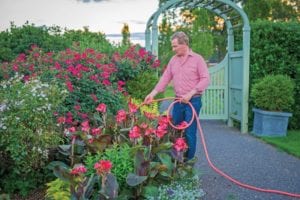I find that my garden can put on a glorious show almost without my help. I have a few favorite perennials and some companion shrubs that never disappoint in my zone 8A garden, including hostas, peonies, iris, hydrangeas and double-flowering peony daylilies. Then comes summer, a different gardening experience altogether. Rising temperatures, spent flowers, insects and disease reassure me that I really do play an important role in the health and beauty of my plants. A little maintenance and a few key chores can make the difference between a good summer garden and a great one. Here’s a helpful checklist.
 1. deadhead flowers for more blooms.
1. deadhead flowers for more blooms.
Deadheading is key to keeping your perennials (and annuals) blooming for as long as possible. Once a flower is spent, the plant begins to develop seeds for future reproduction, which drains a lot of energy from the plant and its roots. When you use a hand pruner to remove the spent flower head, energy is redirected into creating new flower buds. And it makes the plant look a lot better, too!
Some perennials that benefit from deadheading and will likely rebloom include shasta daisies, coneflowers, salvias, coreopsis, bee balm, tall garden phlox and black-eyed Susans. And while some spring-flowering plants will not rebloom, removing spent flowers provides more energy for building and maintaining healthy roots.
Midsummer is also a great time to cut back fall-blooming perennials that may be starting to set early flower buds, like mums and asters. Cut the plant back by about one-third to delay bloom time and create a fuller plant.
 2. fertilizer provides a boost of energy
2. fertilizer provides a boost of energy
A healthy garden starts with healthy soil. If your soil is in good shape, it might not be necessary to add fertilizer. If you notice yellowing leaves or a general failure to perform, consider enriching your soil by top-dressing the plant’s roots with compost. Lucky for me, the chickens at Moss Mountain Farm provide a steady supply of manure and compost. You also can supplement plants with a slow-release granular fertilizer like Osmocote. A balanced 14-14-14 fertilizer will boost roots, green foliage and flower production.
 3. insects and disease are constants in every garden.
3. insects and disease are constants in every garden.
I like to think that if gardening was too easy, I wouldn’t enjoy it as much. So when I’m faced with damage to a plant, I’m ready for the challenge. For diseases like black spot and powdery mildew, make sure your plant is getting proper air circulation. Overcrowding creates an environment that holds moisture, letting disease thrive. Also, don’t water at night or from above. Hand watering or a gentle drip is best for healthy plants.
If you’re still having disease issues, consider using an environmentally friendly product like Neem oil or insecticidal soap. Neem oil is created using an extract from the neem tree, native to India. It is used to treat common plant diseases, prevent ones such as black spot, rust and powdery mildew, and control insects. Because it must be ingested by insects to be effective, it will not harm pollinators like bees, butterflies and ladybugs. It’s also biodegradable and, if used correctly, safe for animals. Insecticidal soap is effective for treating aphids, scale, thrips, sawfly, spider mites, whiteflies and many more. It works on contact, and residual spray on the leaf will have no impact. Genetics also play a role in the disease resistance of plants. Fill your garden with reblooming perennials such as daylilies and tall bearded iris to provide a naturally diseaseresistant solution.
 4. weeding is a necessary evil.
4. weeding is a necessary evil.
Weeding is probably the most unpopular task in my arsenal of maintenance tips, but there’s no avoiding it. Weeds steal valuable nutrients and moisture, so they must go. To avoid the spread of weeds, get to them before they go to seed. You can minimize this dreaded chore by using a quality mulch in your flower beds to retain moisture in the soil, smother existing weeds and prevent weed seeds from embedding in your soil.
 5. when it’s hot and there’s no rain … water!
5. when it’s hot and there’s no rain … water!
Water is a valuable natural resource, and the less supplemental watering you do, the better. But all gardens experience periods of extended drought with high temperatures. Consider watering once a week with a deep soak (30 to 45 minutes) versus a little bit of water every day. Deep watering supports deeper, stronger plant roots, which in turn require less watering.
Soaker hoses are more efficient and waste less water than sprinklers, but there’s no substitute for a good downpour from Mother Nature. The summer perennial garden may not come with the same ease as the spring garden, but it definitely can produce the same pageantry and fanfare—with a little help from you.
P. Allen Smith is an author, conservationist and TV host of Garden Home on PBS and Garden Style (check your local listings). He uses his Arkansas home, Moss Mountain Farm, to promote the local-food movement, organic gardening and the preservation of heritage poultry. For tours of the farm, visit pallensmith.com/tours.








